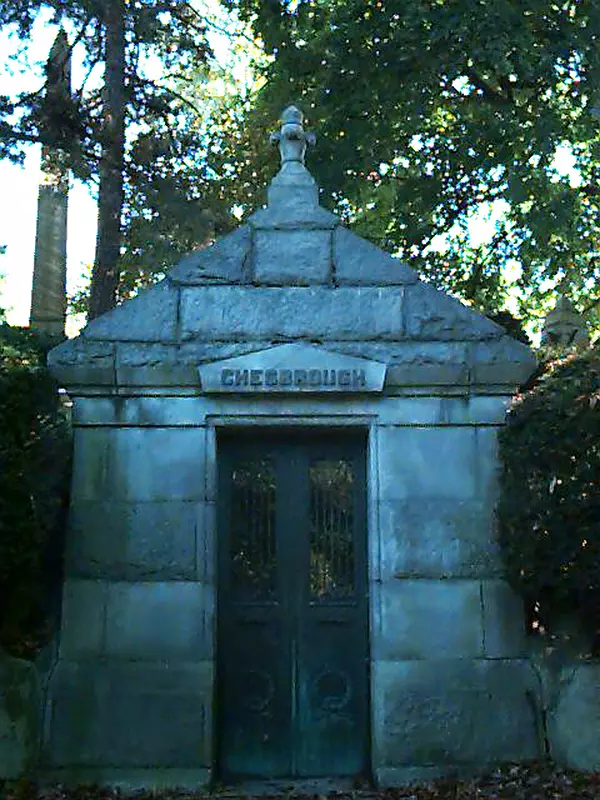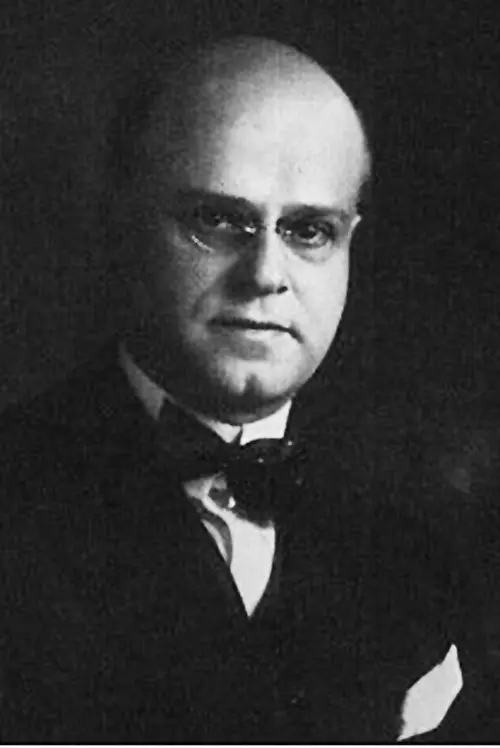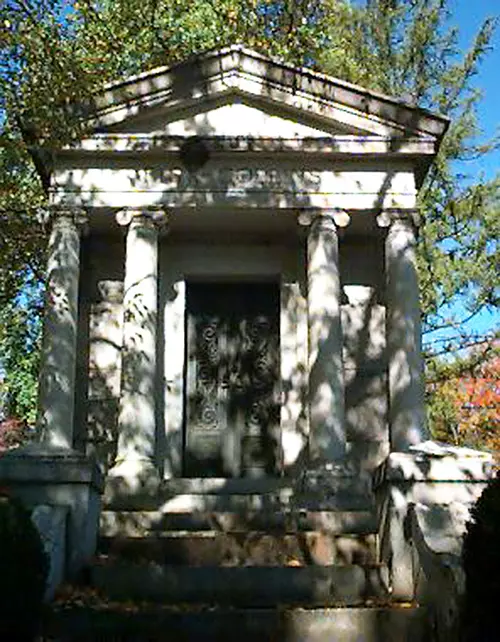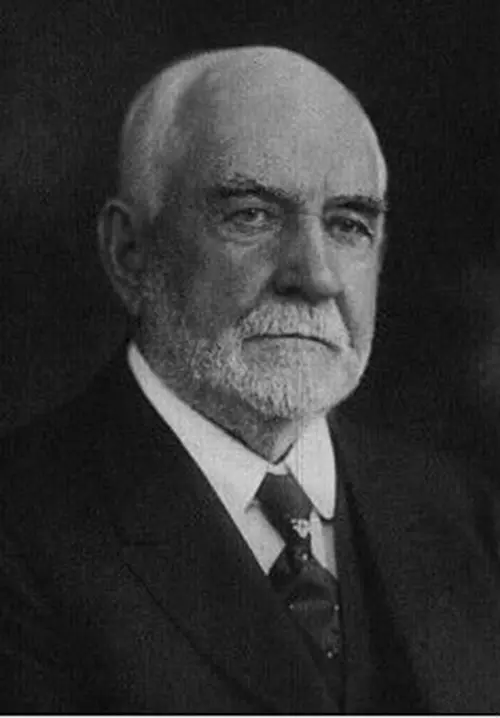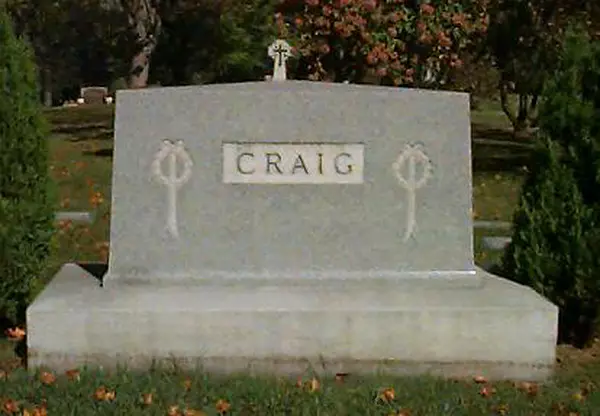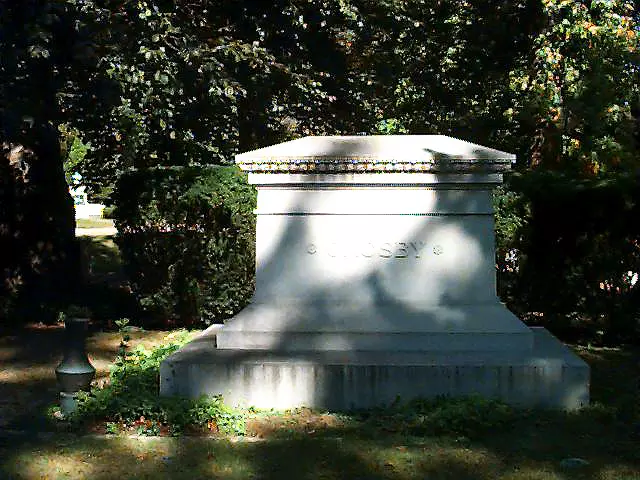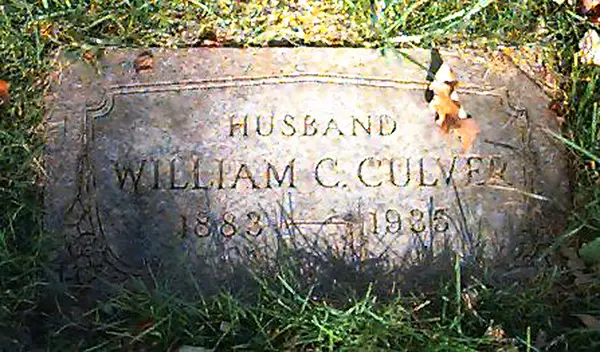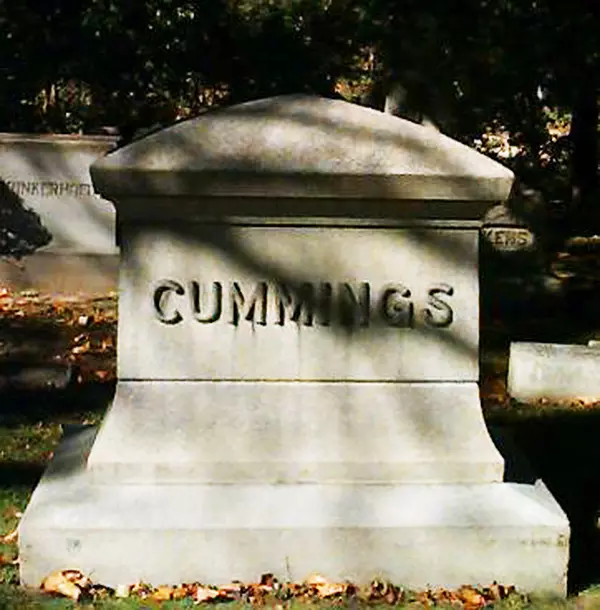Alonzo Chesbrough - Albert "Bert" S. Close - Elmer Harry Close - Frank Collins* - John Craig - Frank, Howard and George Crosby/Crosby Brothers - Frances Crosby - William Culver - Judge Joseph W. Cummings - Robert S. Cummings - William Cummings
*The original list from 1995 (not used herein) had included a Florence Collins biography as well, but the link led to Frank Collins's biography.
Alonzo Chesbrough
Alonzo Chesbrough was born in 1817 and lived his early life in Dorset, Vermont. At age twenty he moved to Lockport, New York and began working for the lumber manufacturing firm of Cameron and Moody. Initially the owners rejected his application, but Chesbrough offered to work for free to prove his abilities. After one day on the job, the company hired him at the highest pay the position allowed.John M. Killits, ed., [Toledo and Lucas County, Ohio, 1623-1923, (Chicago & Toledo: The S.J. Clarke Publishing Company, 1923) Vol. 2, pp. 81-82.]
Alonzo Chesbrough started out as a chopper, moved up through the ranks, and after twenty years, managed the interests of the company. At that time, he decided to strike out on his own. After exploring possible business, Chesbrough settled on Toledo where he established a large and profitable business. Chesbrough's business supplied timber to the government during the Civil War. Construction of the famous ironclad ship "Monitor" included Chesbrough's lumber. As his business expanded, he purchased large tracts in timber regions of Michigan and Ohio. These holdings included 59,000 acres of land on Michigan's northern peninsula.("Abram Morey Chesbrough is Dead in Home," Toledo Times, 29 May 1928 and Killits.)
For over twenty-five years Chesbrough maintained his business headquarters with the firm of Bell, Emerson and Company at the corner of Madison and Summit Streets. In addition to the lumber business, Chesbrough served as the vice-president of the Second National Bank of Bay City, Michigan as well as the Exchange Bank of Lockport.
In 1855, Chesbrough married Sarah J. Rufford. After moving to Toledo, the couple established their home on the east side of the city. There they raised four sons--Fremont, Frank, Abram, and Aaron. Alonzo Chesbrough died in January 1887 and his wife passed away May 17, 1893.
Chesbrough's four sons inherited the business but it Abram assumed the leading role in running the business. Abram Chesbrough had been born at Suspension Bridge, New York in 1860. He moved with his parents to Toledo at the age of seven and attended Toledo Public Schools as a child. In June 1886, he married Belle Brown. They become the parents of one son and two daughters.
After Alonzo's death in 1887, the company became known as Chesbrough Brothers. It operated until 1918 when Abram Chesbrough left to concentrate on his personal interests. He did, however, remain involved in the lumber business until around 1926 when he sold all his remaining interest in lumber mills and other holdings in order to retire. Abram Chesbrough died in May 1928 after a brief illness.(Ibid).
Albert "Bert" S. Close
Albert "Bert" S. Close was born on May 21, 1868 on a farm five miles west of Carey, Ohio. At age sixteen, he started a business career in the dress goods department of the Lamson Brothers Company. Later, he became a traveling salesman for the Toledo wholesale dry goods firm L.S. Baumgardner Company, and then held a similar position with the Blodgett, Orway and Weber Company of Boston. While traveling for this firm Close made contact with Arthur S. Hickok, who at that time operated a dry goods store on Toledos Summit Street. After leaving the dry goods business Close went on a trip around the world.
During his travels, Close witnessed the opportunities created in the oil industry by the increasing popularity of the automobile. In 1912 Close and Hickok organized the Hickok Producing Company and established a gasoline plant at Bloomdale, Ohio. As the company expanded, its owners opened new plants in Bowling Green and acquired large holdings in Texas. Close eventually became Vice-President and General Manager of Hickok Oil Corporation and President of the Breckinridge Gasoline Company.
Close actively participated in the Toledo Club, the Detroit Yacht Club and the Catawba Cliff Club. His enjoyed yachting and owned one of the best known yachts in Toledo, the "Ber-Clo-III", a 106 foot cruiser built for him about 1930. During the summer months, Close lived aboard his yacht.
On October 25, 1932, one week after an operation for appendicitis, Close died. He left part of his estate to the Salvation Army which used the money to provide needy people with checks and yearly Christmas baskets.[Toledo Biography Scrapbook (Christm-Cohn) Local History Collection, Toledo/Lucas County Public Library; "Prominent Oilman Dies," Toledo Blade, 25 October 1932; and "Albert Close, Yachtsman, Oilman Dies," Toledo Newsbee, 25 October 1932.]
Elmer Harry Close
Elmer Harry Close was one of the most important real estate developers in Toledo. He subdivided and developed much of the farmland surrounding Toledo, and helped to promote the city itself.
Close was born in Bellevue, Huron County, Ohio on December 9, 1875, the son of Joseph W. and Gertrude Close. Although he made his living in the grain business, Joseph Close maintained important contacts in real estate, which may have influenced his son. At a young age, Elmer Close gained the reputation of being business minded. He worked as the local agent for the Toledo Bee and became known in Bellevue as "Bee Close." He kept his parents amused by boarding trains stopping at Bellevue and selling apples to passengers.[Toledo Biography Scrapbook (Elmer Harry Close), Local History Collection, Toledo/Lucas County Public Library.]
The younger Close attended school in Bellevue, and then went to the University of Michigan. After graduation, he entered the insurance business in Duluth, Minnesota. But in 1897, Close returned to Toledo to become the partner of George E. Pomeroy, a real estate developer. He stayed with that company for twelve years as secretary and treasurer.
In January 1909 Close went into business for himself, organizing and becoming president and treasurer of the E.H. Close Realty Company, one of the largest realty companies to have its headquarters in Toledo. Its offices were located in the Spitzer building on Madison Avenue. The company grew steadily and by 1914 needed more space, so it moved into the six-story building across the street. Once he had organized his own company, Close began a comprehensive campaign: "It is said that almost every fence and barnyard wall in Toledo carried his placards until the name of the firm was almost a household word."[John M. Killits, ed., Toledo and Lucas County, Ohio 1623-1923 (Chicago and Toledo: S.J. Clarke Publishing Co., 1923), Vol. 2, p. 238.]
Close's company policy promoted home ownership and the development of downtown Toledo. He hoped to stimulate the expansion of the business district through the building of new structures and the remodeling of old ones. As Pomeroy's partner, Close created his first subdivision, Harvard Terrace, near Walbridge Park. In 1911, while on an "epoch making" automobile trip, Close had an important experience that helped to redirect his real estate interests. He had gone to look over houses in the poorer districts of the city which had been listed with him for sale. The cramped dirty conditions and lack of quality living shocked him. He responded by devising a plan of suburbs, linked to the city through a system of streetcars, for the working classes. Low priced lots and monthly payment plans would make the housing affordable. Close bought up farmlands in the west Toledo area and in 1912 initiated his vision with the opening of Homewood. When this development sold out, Homeacres and Homeville followed.
When E. D. Libbey saw the workers moving out of the city into suburbs he asked why executives could not also take advantage of the suburban atmosphere. Close bought a 600 acre tract beyond Secor Road, and in 1913 established Ottawa Hills, a residential area for the wealthy and prominent families of Toledo.
Close became one of the leading realtors of residential subdivisions in the United States. He was also responsible for the large office building, known as the Close Building, located on Madison Avenue in downtown Toledo.
In October 1898, Close married Nell Kempf, the daughter of Reuben Kempf, president of the Farmers and Mechanics Bank of Ann Arbor, Michigan. The couple had two children, Joseph K. and Suzanne G. Close and made their home on Ridgewood Road in Ottawa Hills. Close participated in the Toledo Commerce Club, Toledo Club and Toledo Yacht Club. He owned the lake cruiser "Tillicum." Close served as director of the Northern National Bank and Commerce Guardian Trust and Savings Bank, and as president of the Toledo Real Estate Board.
On August 6, 1924, as Nell Close and the two children cruised the Thousand Islands, a servant discovered Elmer Close's body. His death at fifty years old was believed to have been caused by heart trouble. Nell Close died in 1957.
It has been estimated that Close made it possible for more than 10,000 people in Toledo to own their own homes. At the time of his death, Close owned three miles of frontage on the Dixie Highway, his land paralleled the Pere Marquette improvement in north Toledo. Close is credited with helping Pere Marquette acquire holdings in the 1920s and closing the roads in the path of the railroad.[Killits, pp. 238-241; Nevin O. Winter, A History of Northwest Ohio (Chicago and New York: Lewis Publishing Company, 1917), Vol. 2, pp. 679-680; and Toledo Biography Scrapbook (Elmer Harry Close).]
Frank Collins
Frank Collins was born in Toledo on May 3, 1870. Although he began his education at Old Erie School, he was unable to finish his studies because he was forced to find work when his father died. Frank took advantage of the local canal system and found employment collecting tolls from boats as they came out of the canals to dock at the foot of Madison Avenue. In his early years, Collins also acted as a "snare drummer" in torchlight parades and worked for the National Supply Company.
Frank finally found success in 1903 when he founded and served as the President of the Pipe Threading Machine Company. He was a member of the Merchants and Manufacturers Association and a liquidator of the old Commercial-Guardian Savings Bank and Trust Company. Frank was also identified with The Toledo Hospital. He served as chairman of the building board when the new structure was constructed near Ottawa Park. Collins later named Toledo Hospital as a beneficiary in his will. The hospital received approximately $2 million of his estimated $3,306,497 estate.The Collins family included Florence Fisk whom Collins married on February 11, 1896, as well as a half-brother and half-sister. Frank and Florence occupied the house that Florence had lived in since she was five years old. They used some of their wealth to buy and operate a pleasure yacht, the "Sultona," in the 1890's. After investing in Liberty Bonds the Collinss became involved in a confrontation with the government. The Collinss disagreed with the government's gold policy in 1935-36 and in association with Alton C. Dustin filed suit to test the constitutionality of that policy. They had hoped to force the government to redeem interest payments due on Liberty Bonds in gold, but their court case was unsuccessful when Federal Judge Paul Jones ruled against them.
Florence was born on January 4, 1872 and from her youth was actively involved in charitable work. She was a member of the Collingwood Avenue Presbyterian Church and led a fundraising drive for $110,000 which was to provide for a new church. During the Depression Florence and a number of friends organized the Child Benefit Association which supplied Toledo's needy school children with clothing. It was run from her basement which was converted into a large sewing room. The program was eventually taken over by the Board of Education.
She was a devoted worker for the Red Cross. When World War I came, Florence and Mrs. Sinclair Walbridge were in charge of Toledo's Red Cross headquarters. Almost twenty years after the war she was again active in local affairs by helping the victims of a flood on the Ohio River.
Frank Collins, a long time cancer sufferer, died in February, 1938 and is buried at Historic Woodlawn Cemetery. Florence Collins lived another ten weeks after Frank died. On April 23, 1938, Florence Collins died in her childhood home at the age of 66.[Toledo Biography Scrapbook (cola-colw), Local History Collection, Toledo/Lucas County Public Library. Toledo Times, 13 February 1938. News Bee, 12 February 1938 and 18 February 1938.]
John Craig
John Craig was born in New York City in 1838. His parents, George and Catherine, had traveled to the United States from Scotland in the early 1800s. His father was a ship sawyer who later became identified with the lumber and coal industries of New York. John Craig followed in his father's footsteps and also worked in the shipping trade.
John was educated in the New York public school system. He later attended the College of the City of New York. John later reminisced about his early childhood. He remembered standing on the New York docks in 1851, at the age of twelve years old, as the schooner-rigged yacht "America" sailed away to win the international yacht race. After leaving school he served as an apprentice in the ship building industry.
John Craig was a member of the audience that heard Abraham Lincoln's speech at the Cooper Institute in New York in February 1860. The following November he voted for Lincoln. When the Civil War broke out he contributed to the cause by remodeling merchant craft into gunboats. He helped complete 23 of the vessels for wartime service. One of these boats, the "Winona," was built and delivered to the United States government within 63 days of the contract being signed. He also helped fit out mortar boats for the Porter expedition at Beaufort, North Carolina. John ended his work for the government in 1864.
In 1866 his work shifted to Lake Erie where he became a partner in the Michigan shipbuilding firm of Linn & Craig. The firm built merchant boats for service on Lake Erie. In 1882 Craig transferred to Trenton, Michigan, and continued in the boat business in a firm under his own name. This firm later became John Craig & Son.
While at Trenton Craig experienced problems with the federal contract labor law. He had imported carpenters from Montreal and Quebec. The Supreme Court judged against him and he was fined $43,000. He responded by asking Republicans in Michigan to file petitions for him. With their help he was able to escape with only the payment of costs.
Due to labor shortages in Trenton he transferred his operations to Toledo in 1889 and organized the Craig Shipbuilding Company. After building 107 Great Lakes vessels the firm was sold to the Toledo Shipbuilding Company in 1906. In 1907, the Craig Company established its headquarters at Long Beach, California, and between 1907 and 1913 built ten ocean-going boats for the Pacific coastal service. In 1913, John sold his company to the California Steamship Building Company.
John Craig was also President of the Toledo Steamship Company, Adams Transportation Company, and Monroe Transportation Company. He was director of First National Bank, vice-president of the Toledo Metal Wheel Company, a trustee of Flower Hospital, a member of the Toledo Club, the Toledo Yacht Club, and the Society of Naval Architects and Engineers of New York. He was also involved in the temperance movement as president of the United Dry Campaign of Lucas County.
Craig was also actively involved in politics and became one of the oldest members of the Republican Party. He was at one time a Republican candidate for mayor but factional "warfare" caused him to throw his support behind Golden Rule Jones. Jones was subsequently elected. In 1908, Craig accepted an invitation by the enemies of Walter F. Brown (Republican Leader) for nomination to compete in the Presidential elections. He accepted only on the condition that if his own candidacy failed his delegates would throw their support behind William Howard Taft.
During World War I, John Craig contributed to the war effort as a one dollar a year man. He worked as assistant to the director of the Wood Ship Department of the Naval Offices. He also called attention to the destruction of property in the war. He pointed out that the United States supplied only 40% of the worlds consumption of metal. He encouraged Toledo businessmen to plan more furnaces and mills so that Toledo might become the center of the metal industry. Later, in 1916, he was appointed by Judge John Killits as receiver for the Toledo Railways and Light Company.
John married Annie Losee of New York City in 1861 and the couple had six children (two died in infancy). His sons later followed their father and entered the shipbuilding trade. Captain John Craig, a revered Toledoan, died on 14 January 1934 at the ripe age of 95 years. He is buried in Woodlawn Historic Cemetery, Section 43, Lot 3.[Toledo Biography Scrapbook, Local History Collection, Toledo/Lucas County Public Library. Also see John M. Killits, ed., Toledo and Lucs County, Ohio, 1623-1923, Vol. 2 (Toledo: S.J. Clarke Publishing Company, 1923), pp. 92-97.]
Crosby Brothers
Frank Crosby was a well known Toledo entrepreneur and capitalist. He was the father of George and Howard Crosby who were the brothers of the Crosby Reality and Mortgage Company, a well known real-estate firm in the early 1900s. Frank Crosby was born in Toledo in 1891. He lived briefly in Grand Rapids, Ohio before returning at age nine with his parents to Toledo in 1900.
Frank was a member of the board of directors for and vice president of Peoples Savings Association with which he was connected for 25 years. He was also a member of Collingwood Presbyterian Church and the Toledo Chamber of Commerce. When he died on May 21, 1942, his estate was valued at $124,000. He left $10,000 to nine Toledo charities. This included $2000 for the Toledo Society for Crippled Children and $1000 each for the Boys and Girls Scouts, Salvation Army, YMCA, YWCA, Florence Crittendon Home, Lutheran Orphans Home, and Toledo Society for the Blind. The remainder of his estate was left to his sons Howard and George. George was instructed to divide what was left and allow his brother first choice. Both were joint executors and received equal shares of the estate.
Howard Crosby was a prominent Toledo realtor and civic leader. He and his brother George founded the Crosby Reality and Mortgage Company which he joined when he returned from Irving School in Tarrytown, New York. The company, located at 413 Madison Avenue, specialized in real estate development, management, mortgage loans, and insurance. The Crosby firm was involved in various real estate developments in the area, one such was the Golden Gate Shopping Center which is located in Maumee.
Howard was interested in municipal government and the civic affairs of Toledo. He eventually became the vice president of the City Management League. Howard served as the executive secretary of United Toledo Committee when the organization formed and was known as the executor who promoted Toledos first payroll-income tax. He was also a prominent member and chief fund-raiser of the committee which raised money to support tax and bond issues.
Howard was an active promoter of Toledo area hospitals. In 1946 he became a member of the St. Vincent Hospital Advisory Board. He was also vice president as well as the chairman of several hospital fund-raisers.
Howard Crosby circulated amongst the upper echelons of Toledos wealthiest and socially conscious organizations and families. The various organizations to which he belonged included the National Real Estate Board and Brokers Institute - Urban Land Institute, Christ Presbyterian Church, the Toledo Club, the Inverness Club, and the Belmont Country Club. Howard also served as a member and trustee of the Toledo Area Chamber of Commerce and was a member and president of the Toledo Board of Realtors.
Howard Crosby was the father of twin daughters, Susan Graves and Sallie Ann Bean. He was to have wed Mrs. Kay Crew Anderson on 28 December, 1963, but died of a heart attack on May 4, 1963, at the age of 48. His residence was at 6051 Sylvania.
George Crosby, eldest son of Frank Crosby and older brother of Howard Crosby, was a well known business man who founded the George P. Crosby Realty Company in 1927. George began his career with the E. H. Close Company when only 19 years old. He was vice president in charge of the rental and management department. George eventually left the Close Company and formed the George P. Realty Company. This real estate firm dealt in general insurance and property management. His younger brother, Howard, joined the firm as a sales manager. After successive years in a prosperous business, the brothers formed the Crosby Realty and Mortgage Company. Both companies were located at 413 Madison. In 1939 the Crosby brothers severed their business connections. Howard continued with the Realty and Mortgage Company while George returned to his realty company located at 413 Madison Avenue in the Nasby Building.
After the death of his wife Hazel in 1961, George went into semi-retirement. He continued to retain an office at 5403 Elmer Drive where he managed properties for the New England Merchants National Bank. These properties included a parking lot at Superior Street and Jefferson Avenue, buildings at 13th and Jefferson, and properties at 1815-1819 Adams St.
Throughout his career George also managed the Scott family properties at Ontario and Adams which included the Valentine and Esquire theaters and the Toledo Lucas County Board of Elections. He was a member of the Sanford Collins Lodge, F+AM, Collingwood Presbyterian Church, the Inverness Club, and was affiliated with the Toledo and National Real Estate Boards.
George P. Crosby established a successful real estate business which, in turn, enhanced the Crosby family name throughout Toledo. He was a realtor in the city of Toledo for 42 years. At his death on December 18, 1963, his estate was valued at $776,954. The bulk of his estate was willed to various Toledo charities which included the Toledo Hospital, District Nurse Association, Boys Club, Old Newsboys Association, Luella Cummings School, and the Toledo Society for Crippled Children. The Lucas County Chapter of the American Cancer Society received $10,000 while the Collingwood Presbyterian Church received $5,000. He designated his twenty acre farm in Adams Township for park purposes. He also left benefits to three of his employees. Marceil E. Klinger, his secretary, was left $50,000 or a property at 803 Starr Avenue, Nellie Mussellman, $25,000 or a property at 2117 Ashland, and Walter Dietrick, $10,000. All three employees were also extended rent-free privileges in their occupied homes.(Toledo Biography Scrapbook, Local History Collection, Toledo/Lucas County Public Library.)
Frances Crosby
Frances Crosby was editor of the Toledo News in the early 1900s. She was the first woman editor of a city newspaper in Toledo, and it is possible that she was the first woman editor for a daily newspaper in the United States. Frances, the second of four daughters, was descended from a well-known Toledo family. Her father was Alonzo Noteman, the respected inventor and pioneer druggist of early Toledo. Talent and interest in the newspaper business was a common vein that ran through the Crosby family. Her sister, Maud Gurney, was society and club editor of a Toledo newspaper, while nephew Edward Moore became the associate editor of the Cleveland Plain Dealer.
Frances had a long and distinguished career in the Toledo newspaper business. Before her position with the Toledo News, she had written society news and features for the Commercial, her first Toledo newspaper. She also reported news assignments as well as features. This was especially noteworthy because at the beginning of the 20th century hard news stories were not normally assigned to women reporters. Women who were included on newspaper staff at that time were designated as feature story writers or as society and domestic-related columnists. Frances also worked at the Sunday Courier Journal. Early 20th century journalists who went on location to cover stories usually had to travel on horse-drawn buggies and wrote the report in long hand.
Toledo, in the early 1900s, could have been considered a liberal city in relation to gender issues. The number of women in editorial positions on newspapers was proportionately high for the size of Toledo at the turn of the century. Frances was also associated with Florence Ingales, the society editor of the (Toledo Times, and Kate Murphy, club editor of the Commercial and editor of the Sunday Courier Journal.)
Frances moved to Indianapolis, Indiana, after the death of her husband, Charles Crosby. She resided with her brother-in-law, Percy Oblinger, until her death on January 10, 1931.(Toledo Biography Scrapbook, Local History Collection, Toledo/Lucas County Public Library.)
William Culver
William Culver was a Toledo police detective who had a national reputation for solving crime. He was born in Toledo in 1882. On July 10, 1911 he became a member of the Toledo Police Department and gained the rank of detective on May 16, 1914. He was considered an "ace sleuth," and was especially known for the role he played in rounding up two well-known gangs of robbers.
In 1920 he played an active role in the roundup of the "Cowboy Hill" bank robbers at Franklin Avenue. During the arrest Archie Dennison was killed and Detective Steve Quinn was shot. More importantly, he was responsible for solving the $1,000,000 Toledo Post Office robbery and the Moreton Bond House robbery in 1921 during which two Detroit policemen were killed.
William Culver's knowledge of the underworld and his ability to remember the faces of criminals were two key factors in solving these crimes. State Senator F. W. K. Tom had witnessed the incident from the Toledo Club and mentioned that one of the robbers wore a mask on the lower part of his face. Culver knew that Charles "Splitlip" Schultz had a facial deformity. He arrested Charles and his criminal friend Joe Urbaytis.
William and his partner, "Big Bill" Delehanty, patiently gathered information from the local underworld. William located a watch stolen in the robbery after he learned from a tip-off that a taxi driver had dropped something down a drain. Culver and his partner found the taxi driver and arrested James Feese who promptly confessed and named the other robbers. Schultz, Urbaytis, and Feese were sentenced to long prison terms in Michigan and Federal prisons.
William Culver also had a reputation for being able to identify a "confidence man" at a distance. Because of this, they "steered clear of Toledo."(Toledo Biography Scrapbook, Local History Collection, Toledo/Lucas County Public Library.)
On September 4, 1935, after an illness of several months, William Culver died of septicemia at the age of 53 years. He was survived by his wife, Blanche. On the day he died the flag was flown at half-staff at the Safety Building. At his funeral police colleagues acted as pall-bearers and his body was "escorted" to the grave by a "platoon of uniformed police."(Toledo Blade, 5 September 1935.) Culver is buried in Woodlawn Cemetery in section 145, lot 31.
Joseph W. Cummings
Judge Joseph W. Cummings was a well-known attorney of Toledo, a senior partner in the firm of Cummings and Lott, and a police and probate judge of Toledo. He was born near Mansfield, Richmond County, Ohio in 1839. When he was eight years old his parents moved to Indiana. The son of Robert and Mary Cummings, he attended Ontario Academy and Michigan University where he studied law, graduating with high honors. In 1862 he was admitted to the bar in La Grange County, Indiana.
At the outbreak of hostilities in 1861, Cummings enlisted in an Indiana company, but the company was not used due to a lack of weapons. He later enlisted for 30 days to help in the defense of Washington when it was attacked by General Early and General Breckenridge. Between 1863 and 1865 Joseph Cummings acted as the prosecuting attorney for five counties in northwest Indiana. He later moved to Toledo and became police judge from 1869 to 1873.
Cummings tried his hand at local politics and in 1880 ran as a candidate for mayor. He was defeated in the elections that year. In 1885 he was elected probate judge, successfully standing for reelection.
Cummings married Fannie S. Smith of Green Springs, Ohio and the couple had two children. His son was Robert S. Cummings. Cummings suffered from a chronic liver complaint and on 18 December, 1899, after a nine week illness, Judge Cummings died. He is buried in Section W1/2 11: Lot 13.[Toledo, It's Resources and Their Development: A Souvenir of the Toledo Bee, (Toledo: Toledo Bee, 1890). p. 63, and "Memorial of Judge Cummings," Maumee Valley Pioneer Association Addresses, Memorials and Sketches, (Toledo: Vrooman, Anderson and Bateman, 1900). p. 55.]
Robert S. Cummings
Robert S. Cummings was born in Toledo in 1880. He was the son of Judge Joseph Cummings and a nephew of John Cummings who was a Toledo banker and businessman. Robert attended Toledo public schools and the old Central High School before graduating from the University of Michigan. He was a Toledo tennis champion at one time but was better known for his work in the world of advertising.
Robert spent 25 years as president of the Martin V. Kelley Advertising Company which was, at that time, the largest in the country. When that company dissolved he went into the advertising field on his own. Robert served as vice-president of the Sterling Beeson Advertising Company, and spent most of his life in the advertising business. During World War One he was also active in the Liberty Loans campaigns in Toledo.
Robert was married to Zora Sollberg Cummings and had two children, Robert S., Jr. and Carolyn L. He was a member of many of the social and civic organizations in Toledo, these included the Toledo Club and the Chamber of Commerce. Ill health eventually forced him to resign from all except the Toledo Country Club.
On September 30, 1938, Robert S. Cummings was found in his bedroom by a maid. He had a pistol at his side and a bullet wound to his temple. His suicide at the age of 58 was blamed on the financial crisis that the country was experiencing at the time. He had suffered a nervous breakdown prior to 1929 and never fully recovered. After spending time in Europe, Robert had returned to find the country in the midst of a depression and banks closing down. His distress was aggravated by the second depression that occured in late 1937.(Toledo Biography Scrapbook, Local History Collection, Toledo/Lucas County Public Library. See also Toledo Blade, 30 September 1938. He is buried in Woodlawn Cemetery in Section 12E, Lot 13.)
William Cummings
William Cummings, born in 1818, was actively involved in the civic and social affairs of Toledo and Lucas County.
In 1867 he was present at a meeting that took place at the residence of Dr. S. H. Bergan that proposed the establishment of a Protestant orphans home in Toledo. The meeting subsequently selected 14 women as managers and eight men as advisors. William was one of the eight advisors chosen.Clark Waggoner, ed., [History of the City of Toledo and Lucas County, Ohio, (New York and Toledo: Monsell & Company Publishers, 1888), p. 832.]
In 1875 the New York and Chicago route of the "fast mail trains" was inaugurated. The new system was the concept of Colonel George S. Bangs, General Superintendent of the U.S. Railroad Service. The first train, consisting of four mail cars and two sleepers, left New York at 4:15 a.m. September 16, 1875. The train carried 30 tons of mail and 50 invited guests of the railroad. During the journey from New York to Toledo the train made stops at Albany, Buffalo, and Cleveland. At 10:47 p.m., after 18 hours and 25 minutes, the train arrived in Toledo. William witnessed the historic event as a member of the Toledo delegation.
In 1875, William was elected treasurer of Lucas County. He held the position of County Officer between 1876 and 1878. From 1881 to 1887 William was a member of the Toledo Produce Exchange which worked to help businesses in Toledo. He was also at one time president of the Northern National Bank.
William Cummings died on 13 December 1898 at the age of 79 years.(Ibid., p. 425). He is buried in Lot 13, Section 12 at Woodlawn Cemetery.

